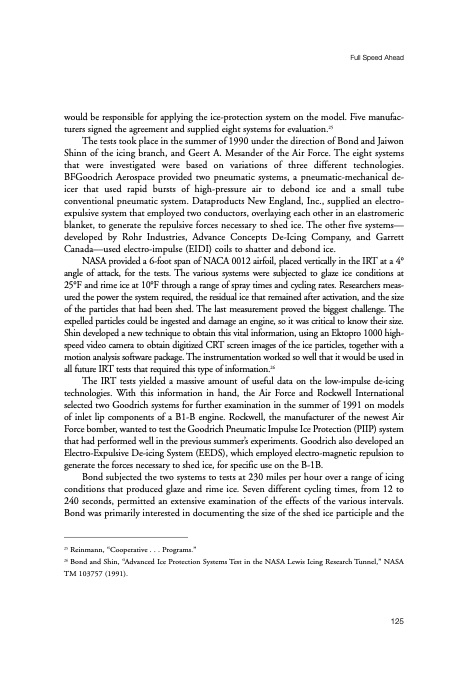
PDF Publication Title:
Text from PDF Page: 137
would be responsible for applying the ice-protection system on the model. Five manufac- turers signed the agreement and supplied eight systems for evaluation.25 The tests took place in the summer of 1990 under the direction of Bond and Jaiwon Shinn of the icing branch, and Geert A. Mesander of the Air Force. The eight systems that were investigated were based on variations of three different technologies. BFGoodrich Aerospace provided two pneumatic systems, a pneumatic-mechanical de- icer that used rapid bursts of high-pressure air to debond ice and a small tube conventional pneumatic system. Dataproducts New England, Inc., supplied an electro- expulsive system that employed two conductors, overlaying each other in an elastromeric blanket, to generate the repulsive forces necessary to shed ice. The other five systems— developed by Rohr Industries, Advance Concepts De-Icing Company, and Garrett Canada—used electro-impulse (EIDI) coils to shatter and debond ice. NASA provided a 6-foot span of NACA 0012 airfoil, placed vertically in the IRT at a 4° angle of attack, for the tests. The various systems were subjected to glaze ice conditions at 25°F and rime ice at 10°F through a range of spray times and cycling rates. Researchers meas- ured the power the system required, the residual ice that remained after activation, and the size of the particles that had been shed. The last measurement proved the biggest challenge. The expelled particles could be ingested and damage an engine, so it was critical to know their size. Shin developed a new technique to obtain this vital information, using an Ektopro 1000 high- speed video camera to obtain digitized CRT screen images of the ice particles, together with a motion analysis software package. The instrumentation worked so well that it would be used in all future IRT tests that required this type of information.26 The IRT tests yielded a massive amount of useful data on the low-impulse de-icing technologies. With this information in hand, the Air Force and Rockwell International selected two Goodrich systems for further examination in the summer of 1991 on models of inlet lip components of a B1-B engine. Rockwell, the manufacturer of the newest Air Force bomber, wanted to test the Goodrich Pneumatic Impulse Ice Protection (PIIP) system that had performed well in the previous summer’s experiments. Goodrich also developed an Electro-Expulsive De-icing System (EEDS), which employed electro-magnetic repulsion to generate the forces necessary to shed ice, for specific use on the B-1B. Bond subjected the two systems to tests at 230 miles per hour over a range of icing conditions that produced glaze and rime ice. Seven different cycling times, from 12 to 240 seconds, permitted an extensive examination of the effects of the various intervals. Bond was primarily interested in documenting the size of the shed ice participle and the Full Speed Ahead 25 Reinmann, “Cooperative . . . Programs.” 26 Bond and Shin, “Advanced Ice Protection Systems Test in the NASA Lewis Icing Research Tunnel,” NASA TM 103757 (1991). 125PDF Image | History of NASA Icing Research Tunnel

PDF Search Title:
History of NASA Icing Research TunnelOriginal File Name Searched:
sp4226.pdfDIY PDF Search: Google It | Yahoo | Bing
NFT (Non Fungible Token): Buy our tech, design, development or system NFT and become part of our tech NFT network... More Info
IT XR Project Redstone NFT Available for Sale: NFT for high tech turbine design with one part 3D printed counter-rotating energy turbine. Be part of the future with this NFT. Can be bought and sold but only one design NFT exists. Royalties go to the developer (Infinity) to keep enhancing design and applications... More Info
Infinity Turbine IT XR Project Redstone Design: NFT for sale... NFT for high tech turbine design with one part 3D printed counter-rotating energy turbine. Includes all rights to this turbine design, including license for Fluid Handling Block I and II for the turbine assembly and housing. The NFT includes the blueprints (cad/cam), revenue streams, and all future development of the IT XR Project Redstone... More Info
Infinity Turbine ROT Radial Outflow Turbine 24 Design and Worldwide Rights: NFT for sale... NFT for the ROT 24 energy turbine. Be part of the future with this NFT. This design can be bought and sold but only one design NFT exists. You may manufacture the unit, or get the revenues from its sale from Infinity Turbine. Royalties go to the developer (Infinity) to keep enhancing design and applications... More Info
Infinity Supercritical CO2 10 Liter Extractor Design and Worldwide Rights: The Infinity Supercritical 10L CO2 extractor is for botanical oil extraction, which is rich in terpenes and can produce shelf ready full spectrum oil. With over 5 years of development, this industry leader mature extractor machine has been sold since 2015 and is part of many profitable businesses. The process can also be used for electrowinning, e-waste recycling, and lithium battery recycling, gold mining electronic wastes, precious metals. CO2 can also be used in a reverse fuel cell with nafion to make a gas-to-liquids fuel, such as methanol, ethanol and butanol or ethylene. Supercritical CO2 has also been used for treating nafion to make it more effective catalyst. This NFT is for the purchase of worldwide rights which includes the design. More Info
NFT (Non Fungible Token): Buy our tech, design, development or system NFT and become part of our tech NFT network... More Info
Infinity Turbine Products: Special for this month, any plans are $10,000 for complete Cad/Cam blueprints. License is for one build. Try before you buy a production license. May pay by Bitcoin or other Crypto. Products Page... More Info
| CONTACT TEL: 608-238-6001 Email: greg@infinityturbine.com | RSS | AMP |